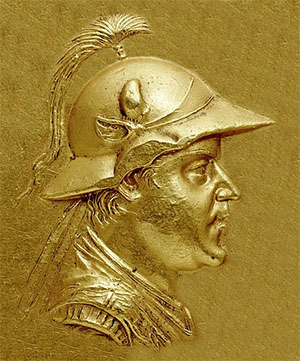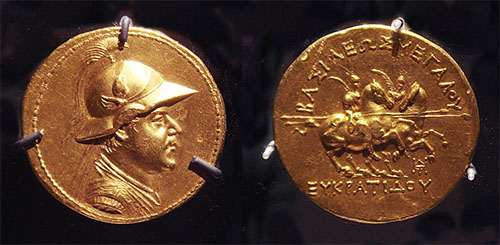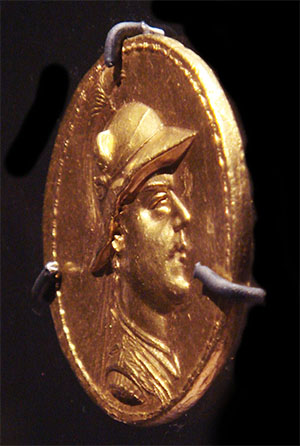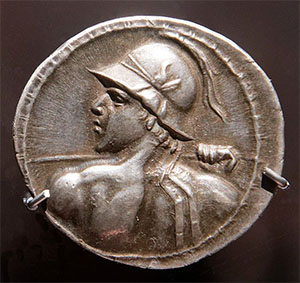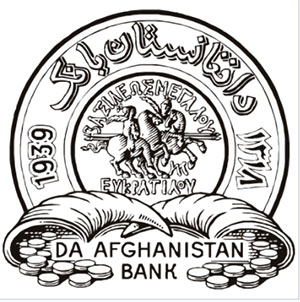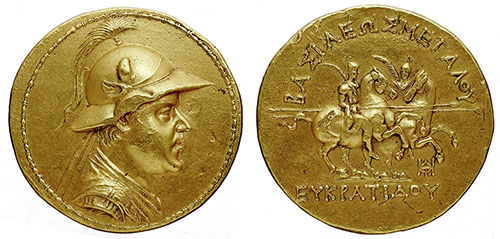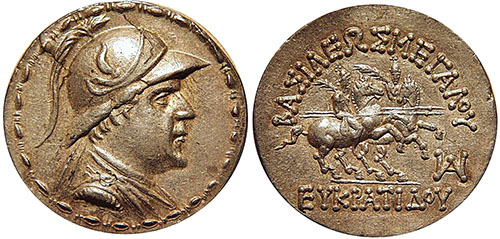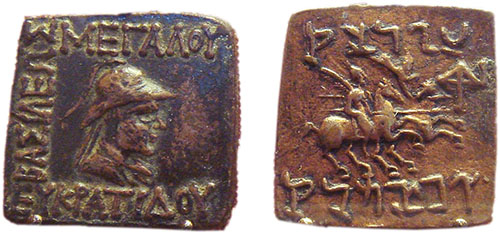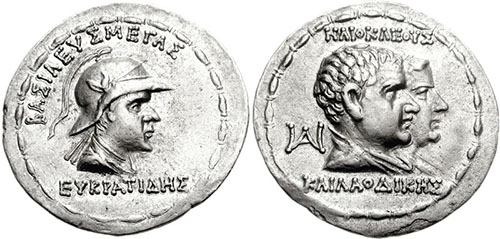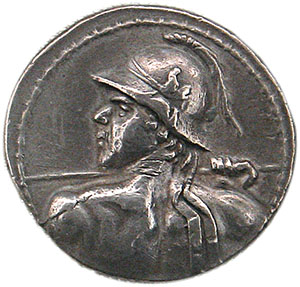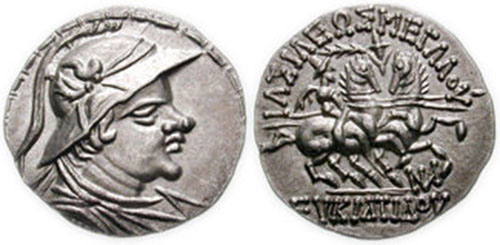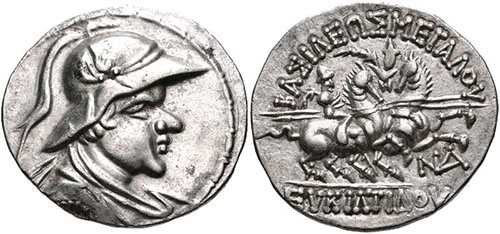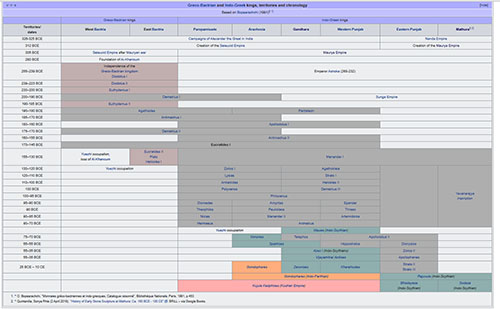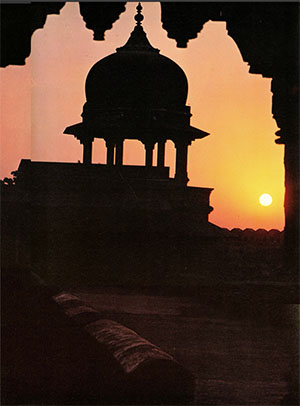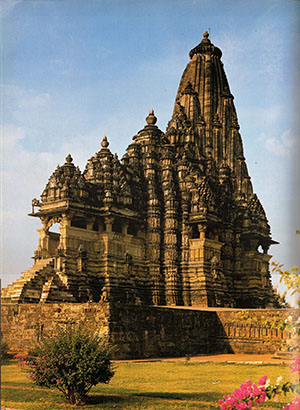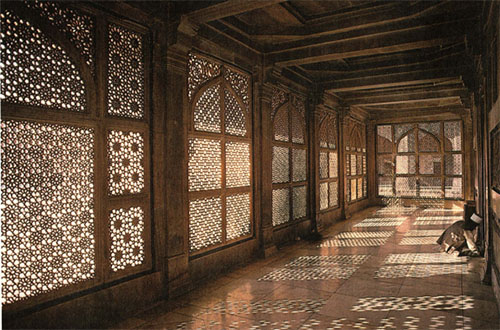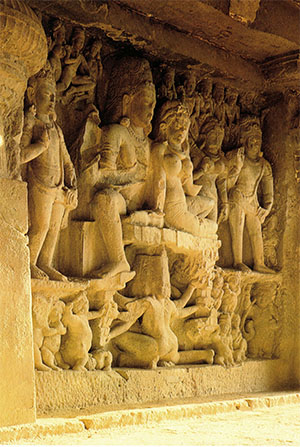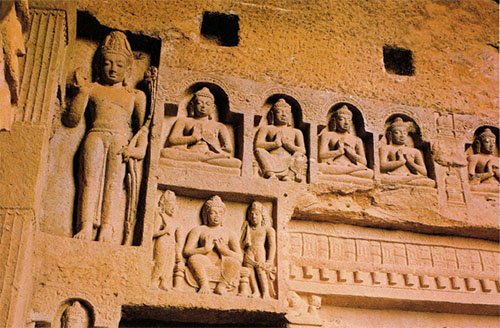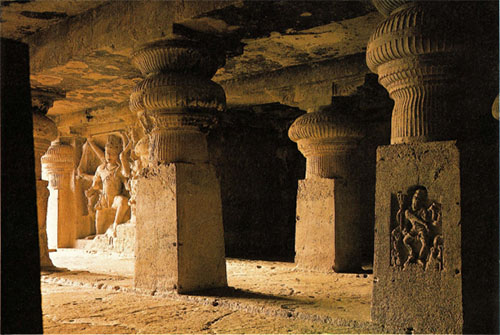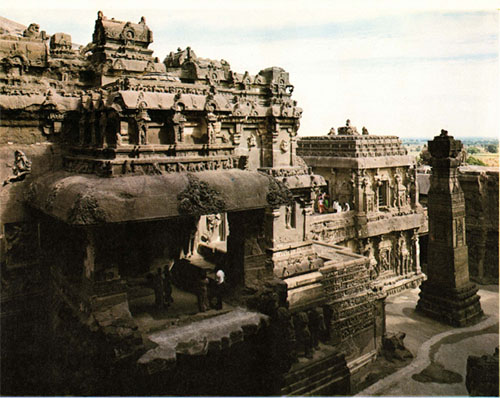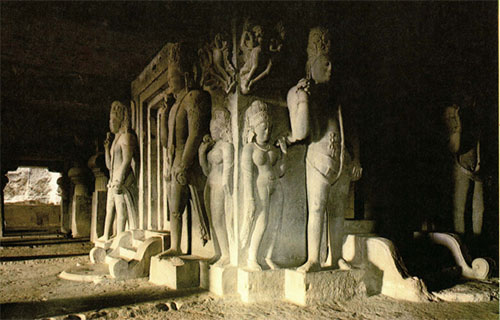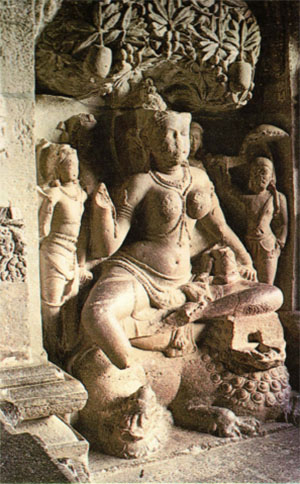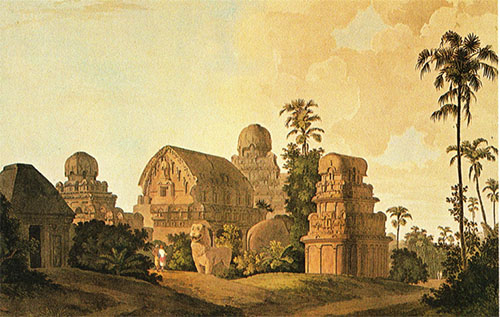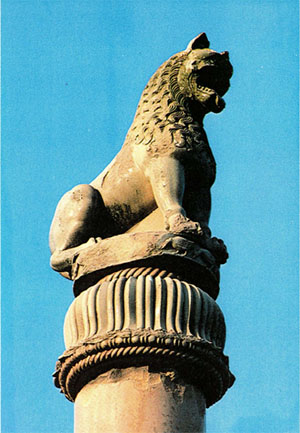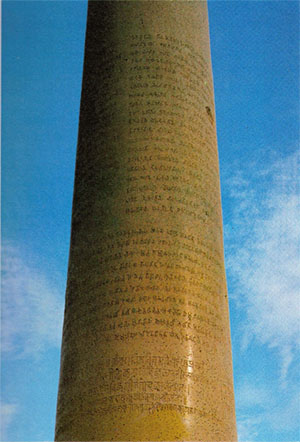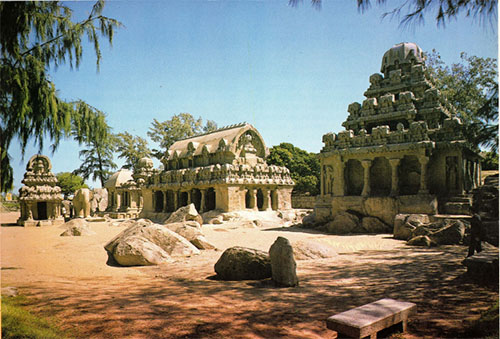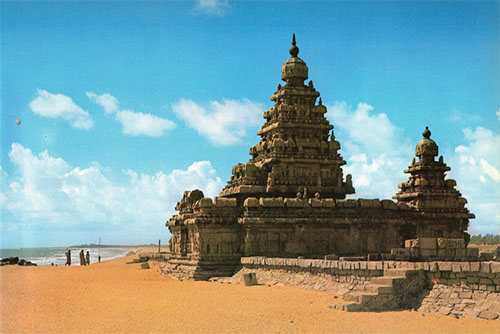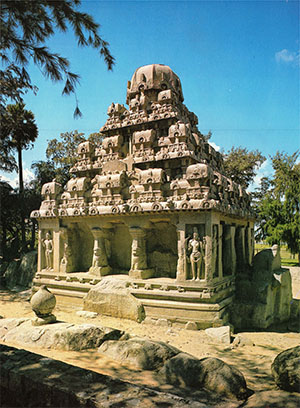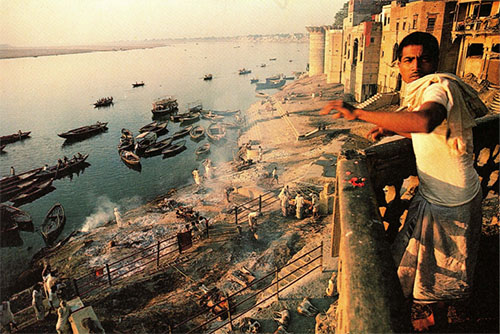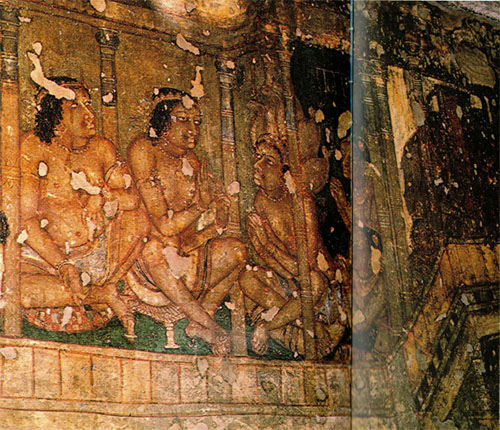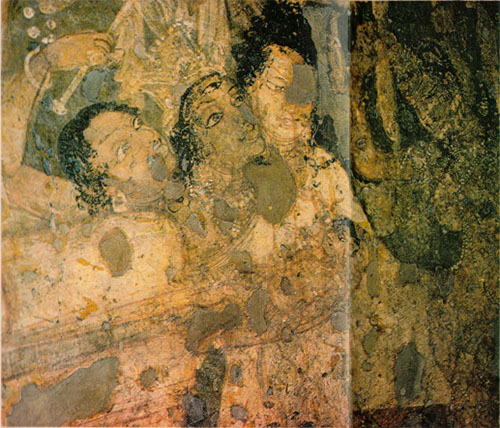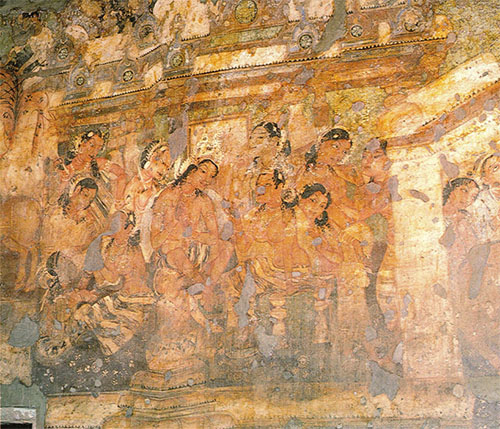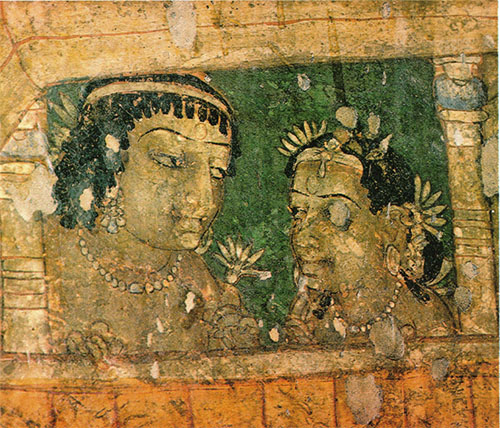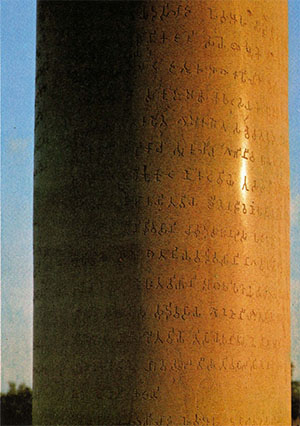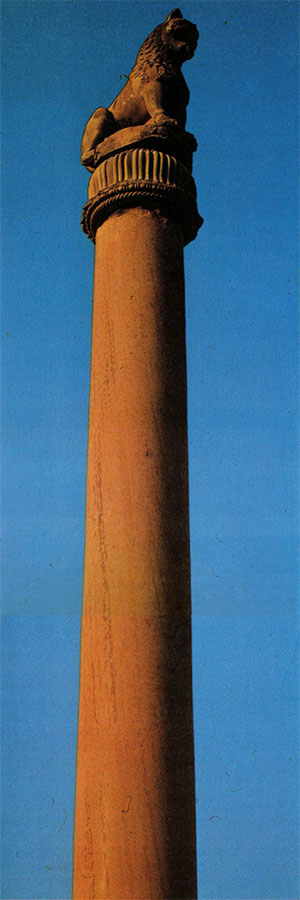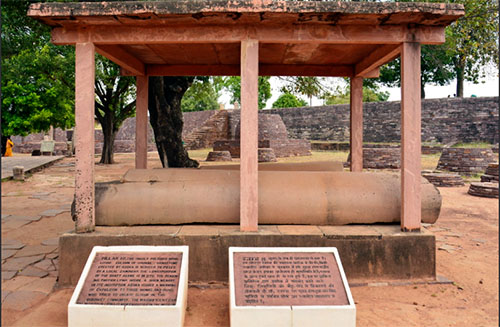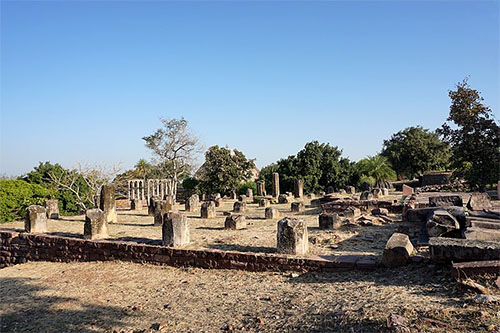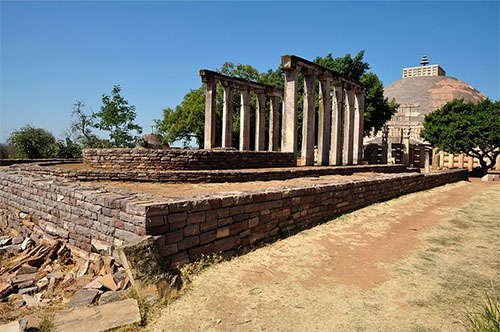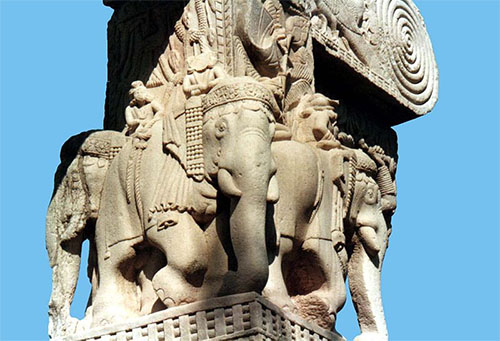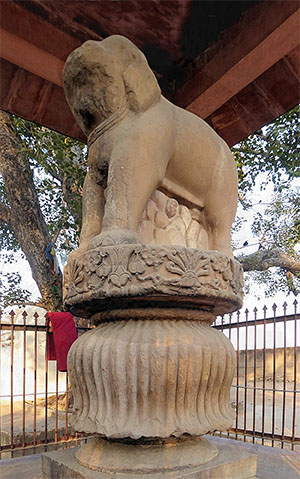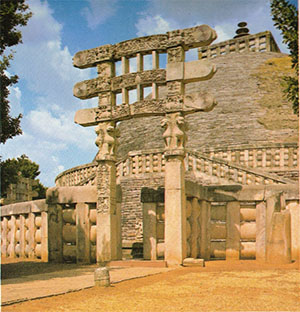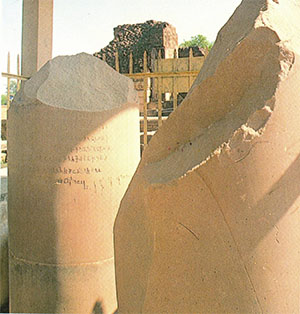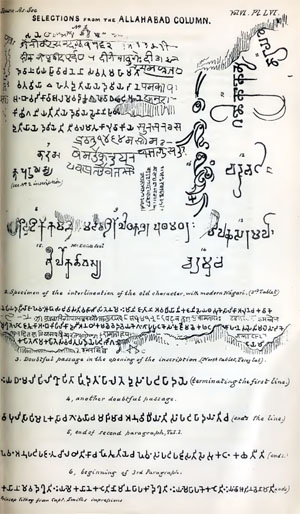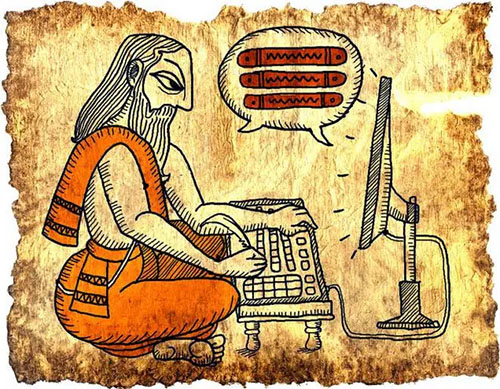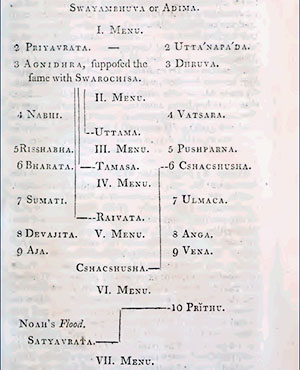Mathuraby Wikipedia
Accessed: 12/28/21
The Shunga Empire was an ancient Indian dynasty from Magadha that controlled areas of the central and eastern Indian subcontinent from around 184 to 75 BCE. The dynasty was established by Pushyamitra Shunga, after taking the throne of the Maurya Empire....
Pushyamitra Shunga ruled for 36 years and was succeeded by his son Agnimitra. There were ten Shunga rulers. However, after the death of Agnimitra, the second king of the dynasty, the empire rapidly disintegrated: inscriptions and coins indicate that much of northern and central India consisted of small kingdoms and city-states that were independent of any Shunga hegemony....
Art, education, philosophy, and other forms of learning flowered during this period including small terracotta images, larger stone sculptures, and architectural monuments such as the stupa at Bharhut, and the renowned Great Stupa at Sanchi....
Artistry also progressed with the rise of the Mathura art style....
However, the city of Mathura further west never seems to have been under the direct control of the Shungas, as no archaeological evidence of a Shunga presence has ever been found in Mathura. On the contrary, according to the Yavanarajya inscription, Mathura was probably under the control of Indo-Greeks from some time between 180 BCE and 100 BCE, and remained so as late as 70 BCE.... The Yavanarajya inscription, states Sonya Rhie Quintanilla, mentions year 116 of the yavana hegemony (yavanarajya), attesting to the 2nd-century and 1st-century BCE Indo-Greek presence. This makes the inscription unique in that it mentions the Indo-Greeks, and it "may confirm" the numismatic and literary evidence which suggests that Mathura was under the ruler of the Indo-Greeks during the period between 185 BCE-85 BCE....
Quintanilla states that the nearly contemporaneous coinage of Menander I (165-135 BCE) and his successors found in the Mathura region, in combination with this inscription, suggests the hypothesis that there was a tributary style relationship between the Indo-Greek suzerains and the Mitra dynasty that ruled that region at the time.
-- Yavanarajya inscription, by Wikipedia
Meanwhile, Kabul and much of the Punjab passed into the hands of the Indo-Greeks...
-- Shunga Empire, by Wikipedia
The Western Satraps, or Western Kshatrapas (Brahmi: [x], Mahakṣatrapa, "Great Satraps") were Indo-Scythian (Saka) rulers of ancient India who ruled over the region of Sindh, Makran, Saurashtra and Malwa (in modern Sindh, Balochistan, Gujarat, Maharashtra, Rajasthan and Madhya Pradesh of India and Pakistan), between 35 and 405 CE. The Western Satraps were contemporaneous with the Kushans who ruled the northern part of the Indian subcontinent, and were possibly vassals of the Kushans...
They are called "Western Satraps" in modern historiography in order to differentiate them from the
"Northern Satraps", who ruled in Punjab and Mathura until the 2nd century CE.-- Western Satraps, by Wikipedia
The Northern Satraps ruled the area from Eastern Punjab to Mathura.
The Northern Satraps (Brahmi: [x], Kṣatrapa, "Satraps" or [x], Mahakṣatrapa, "Great Satraps"), or sometimes Satraps of Mathura, or Northern Sakas, are a dynasty of Indo-Scythian rulers who held sway over the area of Eastern Punjab and Mathura after the decline of the Indo-Greeks, from the end of the 1st century BCE to the 2nd century CE... They are thought to have replaced the last of the Indo-Greek kings in the Eastern Punjab, as well as the Mitra dynasty and the Datta dynasty of local Indian rulers in Mathura.
The Northern Satraps were probably displaced by, or became vassals of, the Kushans from the time of Vima Kadphises, who is known to have ruled in Mathura in 90–100 CE, and they are known to have acted as Satraps and Great Satraps in the Mathura region for his successor Kanishka (127–150 CE).-- Northern Satraps, by Wikipedia
Country: India
State: Uttar Pradesh
District: Mathura
Mathura is a city and the administrative headquarters of Mathura district in the Indian state of Uttar Pradesh. It is located approximately 57.6 kilometres (35.8 mi) north of Agra, and 166 kilometres (103 mi) south-east of Delhi; about 14.5 kilometres (9.0 mi) from the town of Vrindavan, and 22 kilometres (14 mi) from Govardhan. In ancient times, Mathura was an economic hub, located at the junction of important caravan routes. The 2011 Census of India estimated the population of Mathura at 441,894.
In Hinduism, Mathura is birthplace of Krishna, which is located at the Krishna Janmasthan Temple Complex.[7] It is one of the Sapta Puri, the seven cities considered holy by Hindus. The Kesava Deo Temple was built in ancient times on the site of Krishna's birthplace (an underground prison). Mathura was the capital of the kingdom of Surasena, ruled by Kansa, the maternal uncle of Krishna. Janmashtami is grandly celebrated in Mathura every year.
Mathura has been chosen as one of the heritage cities for the Heritage City Development and Augmentation Yojana scheme of Government of India.[8]
History
See also: Mathura art
Mathura, which lies at the centre of the cultural region of Braj[5] has an ancient history and is also believed to be the homeland and birthplace of Krishna, who belonged to the Yadu dynasty. According to the Archaeological Survey of India plaque at the Mathura Museum,[9] the city is mentioned in the oldest Indian epic, the Ramayana. In the epic, the Ikshwaku prince Shatrughna slays a demon called Lavanasura and claims the land. Afterwards, the place came to be known as Madhuvan as it was thickly wooded, then Madhupura and later Mathura.[10] The most important pilgrimage site in Mathura was Katra ('market place'), now referred to as Krishna Janmasthan ('the birthplace of Krishna'). Excavations at the site revealed pottery and terracotta dating to the sixth century BCE, the remains of a large Buddhist complex, including a monastery called Yasha Vihara of the Gupta period, as well as Jain sculptures of the same era.[11][12]
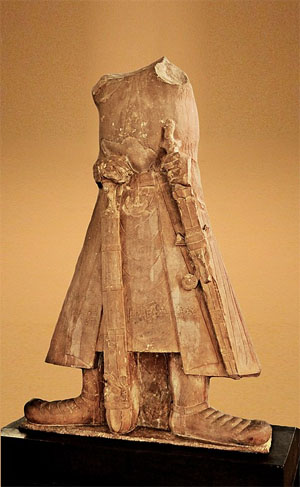 Statue of Kanishka I, 2nd century CE, Mathura Museum.
Statue of Kanishka I, 2nd century CE, Mathura Museum.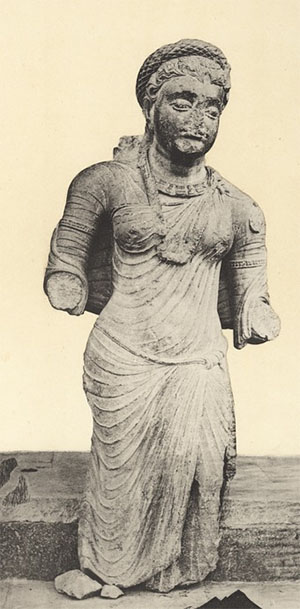 Sculpture of woman from ancient Braj-Mathura ca. 2nd century CE.Ancient history
Sculpture of woman from ancient Braj-Mathura ca. 2nd century CE.Ancient historyArchaeological excavations at Mathura show the gradual growth of a village into an important city during the Vedic age. The earliest period belonged to the Painted Grey Ware culture (1100–500 BCE), followed by the Northern Black Polished Ware culture (700–200 BCE). Mathura derived its importance as a center of trade due to its location where the northern trade route of the Indo-Gangetic Plain met with the routes to Malwa (central India) and the west coast.[13] Archaeologists have discovered a fragment of Mathura red sandstone from Rakhigarhi - a site of Indus Valley civilization dated to 3rd millennium BCE - which was used as a grindstone; red sandstone was also a popular material for historic period sculptures.[14]
By the 6th century BCE Mathura became the capital of the Surasena Kingdom.[15] The city was later ruled by the Maurya empire (4th to 2nd centuries BCE). Megasthenes, writing in the early 3rd century BCE, mentions Mathura as a great city under the name Μέθορα (Méthora).[16] It seems it never was under the direct control of the following Shunga dynasty (2nd century BCE) as not a single archaeological remain of a Shunga presence were ever found in Mathura.[17]
The Indo-Greeks may have taken control, direct or indirect, of Mathura some time between 180 BCE and 100 BCE, and remained so as late as 70 BCE according to the Yavanarajya inscription,[17] which was found in Maghera, a town 17 kilometres (11 mi) from Mathura.[18] The opening of the 3 line text of this inscription in Brahmi script translates as: "In the 116th year of the Yavana kingdom..."[19][20] or '"In the 116th year of Yavana hegemony" ("Yavanarajya")[17] However, this also corresponds to the presence of the native Mitra dynasty of local rulers in Mathura, in approximately the same time frame (150 BCE—50 BCE), possibly pointing to a vassalage relationship with the Indo-Greeks.[17]
Indo-ScythiansAfter a period of local rule, Mathura was conquered by the Indo-Scythians during the 1st century BCE. The Indo-Scythian satraps of Mathura are sometimes called the "Northern Satraps", as opposed to the "Western Satraps" ruling in Gujarat and Malwa. However, Indo-Scythian control proved to be short lived, following the reign of the Indo-Scythian Mahakshatrapa ("Great Satrap") Rajuvula, c. 10–25 CE. The Mora Well inscription of Mahakshatrapa Rajuvula, of the early decades of the first century CE, found in a village seven miles from Mathura, stated that images pratima(h) of the blessed (bhagavatam) five Vrishni heroes, were installed in a stone shrine of a person called Tosa.[21] The heroes were identified from a passage in the Vayu Purana as Samkarsana, Vasudev, Pradyumna, Samba, and Aniruddha.[22] The English translation of the inscription read:-
. . . of the son of mahakṣatrapa Rāṃjūvula, svāmi . . . The images of the holy paṃcavīras of the Vṛṣṇis is... the stone shrine... whom the magnificent matchless stone house of Toṣā was erected and maintained... five objects of adoration made of stone, radiant, as it were with highest beauty...[23]
The Mathura inscription of the time of Mahakshatrapa Rajuvula's son, Mahakshatrapa Sodasa recorded erection of a torana (gateway), vedika (terrace) and chatuhsala (quadrangle) at the Mahasthana (great place) of Bhagavat Vasudeva.[24] Several male torsos representing the Vrisni heroes were also found in a shrine in Mora dating to the time of Mahakshatrapa Sodasa.[21]
Kushan EmpireDuring the rule of the great Kushanas, art and culture flourished in the region and reached new heights and is now famously known as the Mathura School of Art. The Kushans took control of Mathura some time after Mahakshatrapa Sodasa, although several of his successors ruled as Kushans vassals, such as the Indo-Scythian "Great Satrap" Kharapallana and the "Satrap" Vanaspara, both of whom paid allegiance to the Kushans in an inscription at Sarnath, dating to the 3rd year of the reign of the Kushan emperor Kanishka the Great c. 130 CE.[25] Mathuran art and culture reached its zenith under the Kushan dynasty which had Mathura as one of its capitals.[26] The preceding capitals of the Kushans included Kapisa (modern Bagram, Afghanistan), Purushapura (modern Peshawar, Pakistan) and Takshasila/Sirsukh/ (modern Taxila, Pakistan). Mathura ateliers were most active during the epoch of the great Kushan emperors Kanishka, Huvishka, Vasudeva whose reign represents the Golden Age of Mathura sculpture.[27] During 3rd century Nagas ruled Mathura after decline of Kushan Empire.[28]
Gupta EmpireIn the reign of Chandragupta Vikramaditya, a magnificent temple of Vishnu was built at the site of Katra Keshavadeva.[27] Kalidasa, hailed as the greatest poet and dramatist in Sanskrit, in the fourth-fifth century CE mentioned the groves of Vrindavan and Govardhan hill as:
"...the king of Mathura, whose fame was acknowledged in song even by the devatas... At that moment, though still in Mathura, it appears as if Ganga has merged with Yamuna at the Sangam... In a Vrindavan garden which is superior even to Kubera's garden, known as Chaitra-ratha... You can, as well, during rains, look at the dancing peacocks, while sitting in a pleasant cave of the Goverdhan Mountain"[29]
Chinese Buddhist Monk Faxian mentions the city as a centre of Buddhism about 400 CE. He found the people were very well off, there were no taxes other than for those on farmers who tilled the royal land. He found that people did not kill animals, no one consumed wine, and did not eat onion or garlic. He found that engraved title deeds were issued to land owners. Visiting priests were provided with accommodation, beds, mats, food, drinks and clothes to perform scholarly works.[30][page needed]
Harsha EmpireXuanzang, who visited the city in 634 CE, mentions it as Mot'ulo, recording that it contained twenty Buddhist monasteries and five Hindu temples.[31] Later, he went east to Thanesar, Jalandhar in the eastern Punjab, before climbing up to visit predominantly Theravada monasteries in the Kulu valley and turning southward again to Bairat and then Mathura, on the Yamuna river.[32]
Medieval History and Islamic Invasions
Early Middle AgesThe famous female Alvar saint, Andal visualized going to a pilgrimage which began at Mathura, then proceeded to Gokul, the Yamuna, the pool of Kaliya, Vrindavan, Govardhan, and finished at Dwarka.[33] The eleventh century Kashmiri poet, Bilhana visited Mathura and Vrindavan after leaving Kashmir en route to Karnataka.[34]
High Middle AgesThe city was sacked and many of its temples destroyed by Mahmud of Ghazni in 1018 CE.[31] The capture of Mathura by Maḥmūd Ibn Sebüktegīn is described by the historian al-Utbi (Abu Nasr Muhammad ibn Muhammad al Jabbaru-l 'Utbi) in his work Tarikh Yamini as follows:
The wall of the city was constructed of hard stone, and two gates opened upon the river flowing under the city, which were erected upon strong and lofty foundations, to protect them against the floods of the river and rains. On both sides of the city there were a thousand houses, to which idol temples were attached, all strengthened from top to bottom by rivets of iron, and all made of masonry work; and opposite to them were other buildings, supported on broad wooden pillars, to give them strength.
In the middle of the city there was a temple larger and firmer than the rest, which can neither be described nor painted. The Sultan thus wrote respecting it :— “ If any should wish to construct a building equal to this, he would not be able to do it without expending an hundred thousand thousand red dinars, and it would occupy two hundred years, even though the most experienced and able workmen were employed.” Among the idols there were five made of red gold, each five yards high, fixed in the air without support. In the eyes of one of these idols there were two rubies, of such value, that if any one were to sell such as are like them, he would obtain fifty thousand dinars. On another, there was a sapphire purer than water, and more sparkling than crystal; the weight was four hundred and fifty miskals. The two feet of another idol weighed four thousand four hundred miskals, and the entire quantity of gold yielded by the bodies of these idols, was ninety-eight thousand three hundred miskals. The idols of silver amounted to two hundred, but they could not be weighed without breaking them to pieces and putting them into scales. The Sultan gave orders that all the temples should be burnt with naphtha and fire, and levelled with the ground.[35]
The temple at Katra was sacked by Maḥmūd Ibn Sebüktegīn. A temple was built to replace it in 1150 CE.
The Mathura prasasti (Eulogistic Inscription) dated Samvat (V.S.) 1207 (1150 CE), said to have been found in 1889 CE at the Keshava mound by Anton Fuhrer, German Indologist who worked with the Archaeological Survey of India, recorded the foundations of a temple dedicated to Vishnu at the Katra site:Jajja, who carried the burden of the varga, together with a committee of trustees (goshtijana), built a large temple of Vishnu, brilliantly white and touching the clouds.
Jajja was a vassal of the Gahadavalas in charge of Mathura, and the committee mentioned in the prasasti could have been of an earlier Vaishnava temple.[36] The temple built by Jajja at Katra was destroyed by the forces of Qutubuddin Aibak, though Feroz Tughlaq (r. 1351–88 CE) was also said to have attacked it.[37] It was repaired and survived till the reign of Sikandar Lodi (r. 1489–1517 CE).
In the twelfth century, Bhatta Lakshmidhara, chief minister of the Gahadavala king Govindachandra (r. 1114–1155 CE), wrote the earliest surviving collection of verses in praise of the sacred sites of Mathura in his work Krtyakalpataru, which has been described as "the first re-statement of the theory of Tirtha-yatra (pilgrimage)".[38] In his Krtyakalpataru, Bhatta Lakshmidhara devoted an entire section (9) to Mathura.[39]
Later on the city was sacked again by Sikandar Lodi, who ruled the Sultanate of Delhi from 1489 to 1517 CE.[40][41] Sikandar Lodi earned the epithet of 'Butt Shikan', the 'Destroyer of Idols'. Ferishta recorded that Sikandar Lodi was a staunch Muslim, with a passion for vandalizing heathen temples:
He was firmly attached to the Mahomedan religion, and made a point of destroying all Hindu temples. In the city of Mathura he caused masjids and bazaars to be built opposite the bathing-stairs leading to the river, and ordered that no Hindus should be allowed to bathe there. He forbade the barbers to shave the beards and heads of the inhabitants, in order to prevent the Hindus following their usual practices at such pilgrimages.[42]
In Tarikh-i Daudi, of 'Abdu-lla (written during the time of Jahangir) said of Sikandar Lodi:
He was so zealous a Musulman that he utterly destroyed divers places of worship of the infidels, and left not a vestige remaining of them. He entirely ruined the shrines of Mathura, the mine of heathenism, and turned their principal Hindu places of worship into caravanserais and colleges. Their stone images were given to the butchers to serve them as meat-weights, and all the Hindus in Mathura were strictly prohibited from shaving their heads and beards, and performing their ablutions. He thus put an end to all the idolatrous rites of the infidels there; and no Hindu, if he wished to have his head or beard shaved, could get a barber to do it. Every city thus conformed as he desired to the customs of Islam.[43]
Vallabhacharya and Chaitanya Mahaprabhu arrived in the Braj region, in search of sacred places that had been destroyed or lost. In Shrikrsnashrayah, that make up the Sodashagrantha, Vallabha said of his age:
The Malechchhas (non-Hindus in this context) have surrounded all the holy places with the result that they have become infected with evil. Besides, the holy people are full of sorrow. At such a time Krishna alone is my way.[44]
Late Middle AgesThe Portuguese, Father Antonio Monserrate (1536 CE-1600 CE), who was on a Jesuit mission at the Mughal Court during the times of Akbar, visited Mathura in 1580–82, and noted that all temples built at sites associated with the deeds of Krishna were in ruins:-
It (Mathura) used to be a great and well populated city, with splendid buildings and a great circuit of walls. The ruins plainly indicate how imposing its buildings were. For out of these forgotten ruins are dug up columns and very ancient statues, of skilful and cunning workmanship. Only one Hindu temple is left out of many; for the Musalmans have completely destroyed all except the pyramids. Huge crowds of pilgrims come from all over India to this temple, which is situated on the high bank of the Jomanis (Yamuna)...[45]
The Keshavadeva temple was rebuilt by the Bundela Rajah Vir Singh Deo at a cost of thirty-three lakh rupees when the gold was priced at around ₹ 10/- per tola.[46] And the grand structure of the temple in Mathura was regarded a "wonder of the age".[47]
The Mughal Emperor Aurangzeb, built the Shahi-Eidgah Mosque during his rule, which is adjacent to Shri Krishna Janmabhoomi believed to be over a Hindu temple.[48] He also changed the city's name to Islamabad.[49] In 1669, Aurangzeb issued a general order for the demolition of Hindu schools and temples, in 1670, specifically ordered the destruction of the Keshavadeva temple. Saqi Mustaid Khan recorded:
On Thursday, 27th January/15 Ramzan (27 January 1670)... the Emperor as the promoter of justice and overthrower of mischief, as a knower of truth and destroyer of oppression as the zephyr of the garden of victory and the reviver of the faith of the Prophet, issued orders for the demolition of the temple situated in Mathura, famous as the Dehra of Kesho Rai. In a short time by the great exertions of his officers, the destruction of this strong foundation of infidelity was accomplished and on its site a lofty mosque was built by the expenditure of a large sum... Praised be the august God of the faith of Islam, that in the auspicious reign of this destroyer of infidelity and turbulence, such a wonderful and seemingly impossible work was successfully accomplished.
On seeing this instance of the strength of the emperor's faith and the grandeur of his devotion to God, the proud Rajas were stifled, and in amazement they stood like images facing the wall. The idols, large and small, set with costly jewels, which had been set up in the temple, were brought to Agra, and buried under the step of the mosque of the Begum Shahib in order to be continuously trodden upon. The name of Mathura was changed to Islamabad.[50]
The Muslim conquest resulted in the destruction of all Buddhist, Jain, and Hindu temples and monuments in and around Mathura. Buddhism, already in decline, never revived, and for the next four hundred years the Jains and Hindus were unable to erect any temples that were not sooner or later demolished.[51] Many of the sites that had been places of religious importance were abandoned and gradually sank beneath the earth. But some of them were not forgotten, owing to the persistence of oral tradition, the refashioning of a temple into a mosque, or the presence of humble shrines, some of which housed sculptural fragments of earlier buildings. Several of them have survived as places of significance in the modern pilgrimage circuit.[51]
The rebellion in Mathurá district seems to have gained ground. “ On the 14th Rajab, 1080, [28th November, 1669], his Majesty left Dihlí for Akbarábád, and almost daily enjoyed the pleasures of the chase. On the 21st Rajab, whilst hunting, he received the report of a rebellion having broken out at Mauza' Rewarah, Chandarkah, and Surkhrú. Hasan 'Ali Khán was ordered to attack the rebels at night, which he did, and the firing lasted till 12 o'clock the next day. The rebels, unable longer to withstand, thinking of the honour of their families, now fought with short arms, and many imperial soldiers and companions of Hasan ’Alí were killed. Three hundred rebels were sent to perdition, and two hundred and fifty, men and women, caught. Hasan ’Alí, in the afternoon, reported personally the result of the fight, and was ordered to leave the prisoners and the cattle in charge of Sayyid Zain ul-'Abidin, the jágirdár of the place. Çaf Shikan Khán also (who after ’Abdunnabí's death had been appointed Faujdár of Mathura) waited on the emperor, and was ordered to tell off two hundred troopers to guard the fields attached to the villages, and prevent soldiers from plundering and kidnapping children. Námdár Khán, Faujdár of Murádábád, also came to pay his respects. Çafshikan Khán was removed from his office, and Hasan 'Ali Khán was appointed Faujdár of Mathura, with a command of Three Thousand and Five Hundred, 2000 troopers, and received a dress of honour, a sword, and a horse. * * * On the 18th Sha'bán [1st January, 1670), his Majesty entered Agrah. Kokilá Ját, the wicked ringleader of the rebels of District*......, who had been the cause of ’Abdunnabí's death and who had plundered Parganah Sa'dábád, was at last caught by Hasan ’Alí Khán and his zealous peshkár, Shaikh Razíuddin, and he was now sent with the Shaikh to Agrah, where by order of his Majesty he was executed. Kokila's son and daughter were given to Jawahir Khán Nazir [a eunuch]. The girl was later married to Shah Quli, the well-known Chelah; and his son, who was called Fázil, became in time so excellent a Hafiz [one who knows the Qorán by heart], that his Majesty preferred him to all others and even chaunted passages to him. Shaikh Razíuddin, who had captured Kokila, belonged to a respectable family in Bhagalpur, Bihár, and was an excellent soldier, administrator, and companion; he was at the same time so learned, that he was ordered to assist in the compilation of the Fatáwá i 'Alamgiri [the great code of Muhammadan laws]. He received a daily allowance of three rupees.”+ (Haásir i ’Alamgiri, pp. 92 to 91.) Hasan ’Alí Khán retained his office from 1080 to Sha'bán 1087 (October, 1676), when Sulțán Qulí Khán was appointed Faujdír of Mathurá., Asiatic Society of Bengal, Proceedings[52]
Early Modern HistoryAccording the biographer of Raja Jai Singh, Atmaram, when Jai Singh was campaigning against the Jat Raja Churaman Singh, he bathed at Radha kund on the full moon of Kartik, went to Mathura in the month of Shravan in 1724, and performed the marriage of his daughter on Janmashtami. He then undertook a tour of the sacred forests of Braj, and, on his return to Mathura, founded religious establishments and celebrated Holi.[53]
Pilgrimage by the Family of Peshwa of Maratha EmpireDuring the period of the expansion of Maratha Empire, pilgrimage to the holy places in the north became quite frequent. Pilgrims required protection on the way and took advantage of the constant movement of troops that journeyed to and back from their homeland for military purposes. That is how the practice arose of ladies accompanying military expeditions. The mother of Peshwa Balaji Baji Rao, Kashitai performed her famous pilgrimage for four years in the north, visiting Mathura, Prayag, Ayodhya, Banaras, and other holy places.[54]
Religious heritageMathura is a holy city for Hinduism and is considered the heart of Brij Bhoomi, the land of Krishna.[55][56] The twin-city to Mathura is Vrindavan.
There are many places of historic and religious importance in Mathura and its neighbouring towns.[8]
Krishna Janmasthan Temple Complex is an important group of temples built around what is considered to be the birthplace of Krishna.[57][58] The temple complex contains Keshav Deva temple, Garbha Griha shrine, Bhagavata Bhavan and the Rangabhoomi where the final battle between Krishna and Kans took place.[59][7][9][57]
The Dwarkadheesh Temple is one of the largest temples in Mathura.[7] Vishram Ghat at the bank of river Yamuna is said to be the place were Krishna had rested after killing Kans.[7]
Other notable Hindu religious sites and heritage locations includes the Gita Mandir,[60] Govind Dev temple,[60] ISKCON temple,[7] Kusum Sarovar,[60] Naam yog Sadhna Mandir, Peepleshwar Mahadeo Temple[61][62] and Yum Yamuna Temple[61]
Kankali Tila brought forth many treasures of Jain art. The archaeological findings testifies the existence of two Jain temples and stupas. Numerous Jain sculptures, Ayagapattas (tablet of homage),[63] pillars, crossbeams and lintels were found during archaeological excavations. Some of the sculptures are provided with inscriptions that report on the contemporary society and organization of the Jain community.
Most sculptures could be dated from the 2nd century BC to the 12th century CE, thus representing a continuous period of about 14 centuries during which Jainism flourished at Mathura. These sculptures are now housed in the Lucknow State Museum and in the Mathura Museum.
Jama Mosque, Mathura is a notable site for Islam. It was completed by Abd-un-Nabi, governor of Aurangzeb in 1662.
The Mathura Museum is notable for archaeological artefacts, especially those from the Kushan and Gupta empires. It has sculptures associated with Hinduism, Buddhism and Jainism.[9][64]
...
See also• Brij Bhoomi
• Gokul
• Kankali Tila
• Nandgaon
• Goverdhan
• Sonkh
References1. "DM PROFILE | District Mathura, Government of Uttar Pradesh | India".
2. "Uttar Pradesh Police | Officials". uppolice.gov.in. Retrieved 9 January 2020.
3. "Mathura-Vrindavan Mayor Election Result 2017 Live Updates: BJP candidate Mukesh Arya is new Mayor". 1 December 2017.
4. "52nd Report of the Commissioner for Linguistic Minorities in India" (PDF). nclm.nic.in. Ministry of Minority Affairs. Archived from the original (PDF) on 25 May 2017. Retrieved 7 December 2018.
5. Lucia Michelutti (2002). "Sons of Krishna: the politics of Yadav community formation in a North Indian town" (PDF). PhD Thesis Social Anthropology. London School of Economics and Political Science University of London. p. 49. Retrieved 20 May 2015.
6. "Mathura City" (PDF). mohua.gov.in. Retrieved 22 November 2020.
7. Prasad, Dev (2015). Krishna: A Journey through the Lands & Legends of Krishna. Jaico Publishing House. p. 22. ISBN 978-81-8495-170-7.
8. "Mathura: Mathura gets five more 'teerth sthals'". The Times of India. 24 May 2018. Retrieved 23 November 2021.
9. Frederic Salmon Growse (1874). Mathura: A District Memoir. British Library.
10. Pargiter, F.E. (1972). Ancient Indian Historical Tradition, Delhi: Motilal Banarsidass, p.170.
11. Meenakshi Jain (2019). Flight of Deities and Rebirth of Temples: Episodes from Indian History. Aryan Books International. p. 66. ISBN 978-8173056192.
12. "History | District Mathura, Government of Uttar Pradesh | India". Retrieved 12 January 2021.
13. Upinder Singh (2008). A History of Ancient and Early Medieval India: From the Stone Age to the 12th Century. Pearson Education India. pp. 281, 336. ISBN 978-81-317-1120-0.
14. S.gautam, Mantabya; Law, Randall; Garge, Tejas. "Initial Geologic Provenience Studies of Stone and Metal Artefacts from Rakhigarhi".
15. "Imperial Gazetteer of India. v. 18". Digital South Asia Library. 1908. pp. 63–74.
16. Megasthenes, fragment 23 "The Surasenians, an Indian tribe, with two great cities, Methora and Clisobora; the navigable river Iomanes flows through their territory" quoted in Arrian Indica 8.5. Also "The river Jomanes (Yamuna) flows through the Palibothri into the Ganges between the towns Methora and Carisobora." in FRAGM. LVI. Plin. Hist. Nat. VI. 21. 8–23. 11. Archived 10 December 2008 at the Wayback Machine
17. History of Early Stone Sculpture at Mathura: Ca. 150 BCE – 100 CE, Sonya Rhie Quintanilla, BRILL, 2007, p.8-10 [1]
18. Bulletin of the Asia Institute. Wayne State University Press. 2002. p. 70.
19. B. N. Mukherjee (2004). Kushāṇa studies: new perspectives. Firma KLM. p. 13. ISBN 81-7102-109-3.
20. Osmund Bopearachchi; Wilfried Pieper (1998). Ancient Indian coins. Brepols. ISBN 2-503-50730-1.
21. Meenakshi Jain (2019). Flight of Deities and Rebirth of Temples: Episodes from Indian History. Aryan Books International. p. 64. ISBN 978-8173056192.
22. Jitendra Nath Banerjea (1968). Religion in Art and Archaeology: Vaishnavism and Saivism. University of Lucknow. pp. 12–13.
23. Sonya Rhie Quintanilla (2007). History of Early Stone Sculpture at Mathura: Ca. 150 BCE – 100 CE. BRILL. pp. 260–261. ISBN 978-9004155374.
24. Harihar Panda (2007). Prof. H.C. Raychaudhuri, as a Historian. Northern Book Centre. p. 80. ISBN 978-8172112103.
25. A Catalogue of the Indian Coins in the British Museum. Andhras etc.... Rapson, p. ciii.
26. Singh, Upinder (2008). A History of Ancient and Early Medieval India: From the Stone Age to the 12th Century. Pearson Education India. ISBN 9788131716779. Retrieved 29 March 2017.
27. Vasudeva S. Agrawala (1965). Masterpieces of Mathura Sculpture. Prithivi Prakashan, Varanasi. p. 2.
28. Ashvini Agrawal 1989, p. 54.
29. Rajendra Tandon (2010). Kalidasa: Raghuvamsham. Rupa Publication. pp. 45–51. ISBN 978-8129115867.
30. Beal, Samuel (1884). Si-Yu-Ki: Buddhist Records of the Western World (translated from chinese). London: Truebner & Co.
31. Chisholm, Hugh, ed. (1911). "Muttra" . Encyclopædia Britannica. 19 (11th ed.). Cambridge University Press. pp. 101–102. (Mathura)
32. Yule, Henry; Douglas, Robert Kennaway (1911). "Hsüan Tsang" . In Chisholm, Hugh (ed.). Encyclopædia Britannica. 13 (11th ed.). Cambridge University Press. p. 844.
33. Friedhelm Hardy (2001). Viraha-bhakti: The Early History of Kṛṣṇa Devotion in South India. Oxford University Press, Varanasi. p. 424. ISBN 978-0195649161.
34. (trans.) Georg Bühler (1875). The Vikramânkadevacharita, a life of King Vikramâditya – Tribhuvanamalla of Kalyâna by Bilhana. Bombay, Government central book depôt. p. 18.
35. Sir Henry Miers Elliot & John Dowson (1867). The History of India, as told by its own Historians Volume 2. pp. 44–45.
36. Meenakshi Jain (2019). Flight of Deities and Rebirth of Temples: Episodes from Indian History. Aryan Books International. p. 67. ISBN 978-8173056192.
37. Meenakshi Jain (2019). Flight of Deities and Rebirth of Temples: Episodes from Indian History. Aryan Books International. p. 68. ISBN 978-8173056192.
38. K.V. Rangaswami Aiyangar (1942). Krtyakalpataru of Bhatta Lakshmidhara, Vol.8. Oriental Institute, Baroda. p. lxxxvii–lxxxviii.
39. K.V. Rangaswami Aiyangar (1942). Krtyakalpataru of Bhatta Lakshmidhara, Vol.8. Oriental Institute, Baroda. p. १८६-१९४ (186–194).
40. Sultan Sikandar Lodi Archived 4 March 2016 at the Wayback Machine The Muntakhabu-'rūkh by Al-Badāoni (16th-century historian), Packard Humanities Institute.
41. Lodi Kings: Chart The Imperial Gazetteer of India, 1909, v. 2, p. 369..
42. John Briggs (1908). History of the rise of the Mahomedan power in India till the year A.D. 1612 Volume 1. p. 586.
43. Sir H.M. Elliot & John Dowson (1873). History of India, as told by its own Historians: the Muhammadan period Vol.4. p. 447.
44. Richard Barz (1992). Bhakti Sect Of Vallabhacarya. Motilal UK Books of India. p. 16. ISBN 978-8121505765.
45. J. S. Hoyland (trans.), S. N. Banerjee (annotator) (1922). Commentary of Father Monserrate. Oxford University Press. p. 93.
46. "Historical Gold Prices". sdbullion.com. Retrieved 2 February 2021.
47. Jadunath Sarkar (1928). History Of Aurangzib Vol.3. p. 266.
48. Asher, Catherine B (24 September 1992). Architecture of Mughal India. ISBN 9780521267281.
49. Fisher, Michael H. (2018). An Environmental History of India: From Earliest Times to the Twenty-First Century. Cambridge University Press. p. 109. ISBN 978-1-107-11162-2.
50. Jadunath Sarkar (1947). Maasir-i-Alamgiri, A History Of Emperor Aurangzeb by Saqi Mustaid Khan. p. 60.
51. A. W. Entwistle (1987). Braj: Centre of Krishna Pilgrimage (PDF). Egbert Forsten Publishing. pp. 122–124. ISBN 978-9069800165.
52. Asiatic Society of Bengal (1873). Proceedings. Government Press, North-western Provinces and Oudh. p. 14.
53. Ashim Kumar Roy (2006). History of the Jaipur City. Manohar Publishing. p. 228. ISBN 978-8173046971.
54. Govind Sakharam Sardesai (1946). New History of the Marathas, Vol. 2. Phoenix Publication. p. 243.
55. Prasad, Dev (2015). Krishna: A Journey through the Lands & Legends of Krishna. Jaico Publishing House. p. 16. ISBN 978-81-8495-170-7.
56. Lucia Michelutti (2002). "Sons of Krishna: the politics of Yadav community formation in a North Indian town" (PDF). PhD Thesis Social Anthropology. London School of Economics and Political Science University of London. p. 46. Retrieved 14 September 2019.
57. Krishna, Nanditha (2018). The Book of Avatars and Divinities. Penguin Random House India. ISBN 9780143446880.
58. Vemsani, Lavanya (2016). Krishna in History, Thought, and Culture: An Encyclopedia of the Hindu Lord of Many Names: An Encyclopedia of the Hindu Lord of Many Names. ABC-CLIO. pp. 140–141. ISBN 978-1-61069-211-3.
59. Aug 2019, ANI | 24; Ist, 07:07 Pm. "Devotees throng 'Krishna Janmbhumi' in UP's Mathura on occasion of 'Janmashtami'" – via economictimes.indiatimes.com.
60. Gupta, Sonam (15 May 2017). "Mathura Temple – The Famous Temples of Mathura". The Times of India. Retrieved 20 April 2021.
61. "Exploring 5 ancient temples of Mathura". Times of India Travel.
62. Lal, Kanwar(1961). Holy Cities of India, Delhi : Asia Press, p.285.
63. Das 1980, p. 171.
64. Adhikari, Shona (18 August 2002). "Priceless artefacts hidden away from tourists' eyes". Tribune. Retrieved 13 September 2019.
65. Jaiswal, Anuja (3 September 2018). "Over 30 lakh devotees assemble in Mathura to celebrate Krishna Janmashtami". The Times of India. Retrieved 14 September 2019.
66. "One million devotees celebrate Janmashtami in Mathura". Deccan Herald. 28 August 2013. Retrieved 12 September 2019.
67. "Janmashtami 2019: 23rd or 24th Aug- when Mathura is celebrating Lord krishna's birth?". DNA India. 22 August 2019. Retrieved 14 September 2019.
68. "Maps, Weather, and Airports for Mathura, India". Retrieved 3 June 2016.
69. "Station: Mathura Climatological Table 1981–2010" (PDF). Climatological Normals 1981–2010. India Meteorological Department. January 2015. pp. 481–482. Archived from the original (PDF) on 5 February 2020. Retrieved 22 September 2020.
70. "Extremes of Temperature & Rainfall for Indian Stations (Up to 2012)" (PDF). India Meteorological Department. December 2016. p. M220. Archived from the original (PDF) on 5 February 2020. Retrieved 22 September 2020.
71. "Provisional Population Totals Paper 1 of 2011 : Uttar Pradesh". 2011 Census of India. Ministry of Home Affairs, Government of India. Retrieved 10 February 2013.
72. "C-16 Population By Mother Tongue – Town level". censusindia.gov.in. Retrieved 2 April 2021.
73. "UP Lok Sabha Election | Poll harvest season: Hema Malini starts campaigning from wheat farms in Mathura with sickle in hand". The Economic Times. Retrieved 1 June 2021.
74. Ahmad, F. "12177/Howrah – Mathura Chambal Express – Howrah to Mathura NCR/North Central Zone – Railway Enquiry". indiarailinfo.com.
75. "Mathura to get tram network by 2018". The Times of India. 9 June 2017. Retrieved 20 April 2021.
76. "International airport now at Mathura". Deccan Herald. 22 May 2012. Retrieved 3 June 2016.
77. Srivsatava, Piyush (20 December 2012). "Akhilesh's plan of an international airport in Agra may not take off". India Today. Retrieved 30 January 2020.
78. "Centre invites proposal from UP for airport near Mathura – Times of India". Retrieved 3 June 2016.
79. "Ajit Singh asks Akhilesh Yadav to send proposal for airport at Mathura". The Economic Times. 11 June 2012. Retrieved 16 March 2021.
80. Pike, John. "India – Army Central Command Order of Battle". Retrieved 3 June 2016.
81. "ORGANISATIONAL STRUCTURE". Archived from the original on 19 February 2009. Retrieved 3 June 2016.
82. "www.india-defence.com/reports/3115". Archived from the original on 5 February 2012. Retrieved 3 June 2016.
83. "IndianOil Corporation | Mathura Refinery". Iocl.com. Retrieved 17 November 2013.
84. "Mathura refinery: Latest News & Videos, Photos about Mathura refinery | The Economic Times - Page 1". The Economic Times. Retrieved 1 June 2021.
85. "Mathura University". Upvetuniv.edu.in. 25 October 2001. Archived from the original on 11 December 2013. Retrieved 17 November 2013.
• Mathura-The Cultural Heritage. Edited by Doris Meth Srinivasan, published in 1989 by AIIS/Manohar.
• Konow, Sten. Editor. 1929. Kharoshthī Inscriptions with Exception of those of Ashoka. Corpus Inscriptionum Indicarum, Vol. II, Part I. Reprint: Indological Book House, Varanasi, 1969.
• Mukherjee, B. N. 1981. Mathurā and its Society: The Śaka-Pahlava Phase. Firma K. L. M. Private Limited, Calcutta.
• Sharma, R. C. 1976. Mathura Museum and Art. 2nd revised and enlarged edition. Government Museum, Mathura.
• Growse, F. S. 1882. " Mathura A District Memoir.
• Drake-Brockman, D. L. 1911. "Muttra A Gaztteer".
• The Jain stûpa and other antiquities of Mathura, by Smith, Vincent Arthur, 1848–1920. (1901)
• 1018: Mahmud Ghazni’s invasion of Mathura
• Das, Kalyani (1980), Early Inscriptions of Mathurā
External links• Entry on Mathura in the Dictionary on Pali Proper Names
